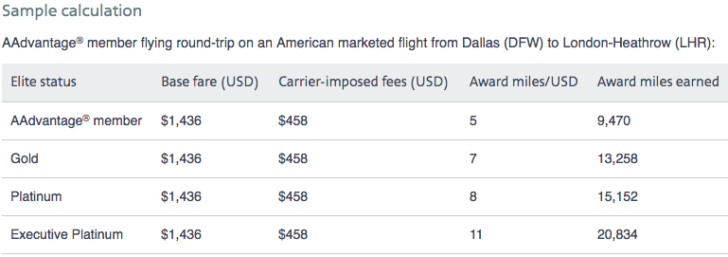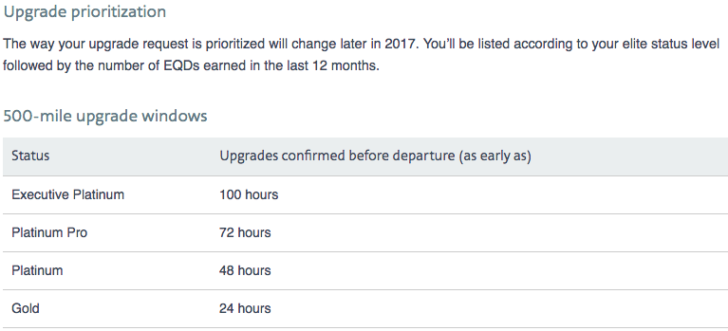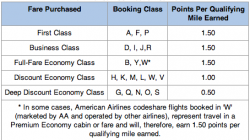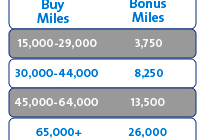American Airlines announced several sweeping changes to its loyalty program last year, including a devalued award chart, fewer upgrades for elite members, and plans to begin awarding miles on the basis of revenue — rather than distance — sometime in 2016.
Well, a big announcement from American Airlines today answers some of those questions and reveals even more we didn’t know was being discussed. Revenue-based earning will go live in August of this year. In addition, American is planning changes to elite upgrades, creating a new revenue component for earning elite status, and adding a new elite tier between Platinum and Executive Platinum. I’ll discuss each in turn.
Revenue-Based Earning
For travel starting August 1, 2016, the price of your ticket and your elite status will determine how many award miles you earn with American AAdvantage. This system is similar to those previously implemented by United Airlines and Delta Air Lines.

A common question I get is what happens to the bonus miles you used to earn as an elite member. Those aren’t gone. Instead they’re calculated differently. Notice that elite members are earning more miles per dollar — that’s your bonus. Elite members actually get higher bonuses under the new program, but another way of looking at it is that members with no status are just suffering more.
Revenue-based programs tend to mean fewer miles for almost everyone except those who buy expensive fares, either for last-minute business travel or in premium cabins. Just take a look at this example provided by American for a sample flight between Dallas and London.

This itinerary is 9,500 miles long, so it would normally earn 9,500 award miles for a general member. Not much difference between the old and new systems. An Executive Platinum member normally receives a 100% elite bonus, for a total of 19,000 miles. They actually earn slightly more. On the surface this looks like nothing is changing.
However, American’s chart separated the base fare and carrier surcharge (both of which earn miles) and does not display government taxes or fees (which don’t earn miles). On a fare like this, taxes and fees are about $200, so while many readers might focus on the $1,436 base fare this is really a ~$2,200 ticket.
Keep in mind that not everyone will pay this much; I could book the exact itinerary next month for $1,035 all-in ($350 base fare). Others might pay more. But if you pay less — and most people try to pay less — then my counterexample shows you could easily earn half as many miles under the new program. Check out GCMap to calculate the distance of a sample itinerary.
Revenue-Based Status
When American Airlines first changed its loyalty program, some were excited that they hadn’t adopted elite qualifying dollars (EQDs) — a revenue-tracking model similar to elite qualifying miles. United and Delta already have EQDs, enabling them to deny status to members who manage to fly thousands of miles on the cheap.
That will change beginning January 1, 2017 — when you begin earning miles and EQDs to determine your status for the 2018 program year. If you’re a business traveler who’s required to buy the least expensive fare (or a leisure traveler who just buys whatever’s cheapest), you could end up losing your status under these new rules.


Elite qualifying dollars are calculated by adding the base fare and the mandatory carrier surcharges. They do not include government taxes and fees. This is very similar to how award miles will be tracked under the new revenue-based earning scheme. However, keep in mind that elite qualifying miles (EQMs) are still based on distance. Award miles and elite miles are not the same.
To earn elite status, you will need to reach the new EQD threshold and one of the following: (1) an EQM threshold based on distance flown or (2) an EQS threshold based on the number of flight segments flown. The EQM and EQS thresholds are unchanged and carried over from the old program.
New Platinum Pro Elite Tier
From the chart above you can see that American AAdvantage is adding a fourth elite tier: Platinum Pro. This will sit between Executive Platinum and Platinum and matches other programs offered by United and Delta, which have four elite tiers spaced roughly 25,000 miles apart. It offers a nice break if you can’t reach all the requirements for Executive Platinum but still travel more than the average Platinum member. Benefits include:
- Complimentary upgrades on flights within North and Central America.
- 9 award miles per dollar
- 2 free checked bags
- oneworld Sapphire status
I view this as essentially the same as Platinum status but with a higher upgrade priority and more miles. You can earn Platinum Pro status next year, once the new EQD requirements go into effect.
New Complimentary Upgrade Priority
American AAdvantage already reduced the number of systemwide upgrades it would issue to Executive Platinum members and their unlimited domestic upgrades. However, it kept in place a model of 500-mile “coupons” that was used by lower elite tiers. Although they aren’t unlimited, some people believe that they are a better model because you can choose which flights are most important to you. Maybe even a Gold member will clear the list if the Platinum members above them aren’t interested and don’t request an upgrade.
Now that 500-mile upgrade system is going to become more challenging. Because Platinum Pro members get unlimited upgrades just like Executive Platinum members, that means a new group of customers will be considered eligible for upgrade even without making a formal request. Executive Platinum members, who already received unlimited upgrades without redeeming 500-mile coupons, will now see their upgrade privileges extended to award travel.
Bottom line: members in the Gold and Platinum elite tiers should expect fewer upgrades.
Furthermore, American is adding a new method for ranking upgrades. It will still consider elite status first. If two members have the same status, American will prioritize the traveler with more EQDs in the last 12 months (i.e., the person who’s spent more in total — not on the individual ticket).

Summary
Overall these changes suggest fewer miles for most members, fewer upgrades for most members, and the loss of elite status (or lower status) for some members. If you don’t spend enough money, American AAdvantage will cut your benefits.
The changes aren’t that drastic if you compare them to United MileagePlus and Delta SkyMiles. They’re fairly consistent with the other two large U.S. carriers. However, this also means that American has lost some of its differentiation. If it’s just the same as the other two when it comes to miles and upgrades, the only reasons left to fly American are because it excels at service, route network, or price. The first is subjective, the second is personal, and the third isn’t the most important factor to every traveler.
Alaska Airlines and its Mileage Plan remains the only U.S. airline loyalty program with a traditional distance-based rewards model. It doesn’t work well for everyone — certainly it fails on the route network issue if you don’t live on the West Coast — but it is still a partner with American and Delta, meaning you could choose to credit your miles there if you must fly the bigger airlines.
Alaska executives have previously stated that they view their loyalty program as an important competitive advantage. That said, they continue to explore all their options, and it’s possible that they, too, could adopt a revenue-based model in the future after their pending acquisition of Virgin America.


